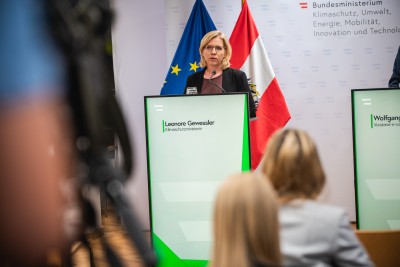Austria's Gas Storage Facilities Almost 60 Percent Full
As a result of the war in Ukraine, contingency plans are being put in place in Europe, as well as in Austria, to secure gas supplies. Gas storage facilities in Austria are 59.83 percent full. This means that a total of 57.2 terawatt hours (TWh) of natural gas is stored in domestic storage facilities.
 The ministry, under Leonore Gewessler, stresses that the 80 percent storage target is achievable by Nov. 1. / Picture: © BMK / Cajetan Perwein
The ministry, under Leonore Gewessler, stresses that the 80 percent storage target is achievable by Nov. 1. / Picture: © BMK / Cajetan Perwein
This corresponds to about 64 percent of the annual gas consumption in Austria, as the climate and energy ministry (BMK) of Leonore Gewessler (Greens), is responsible for energy issues.
Daily injection volumes have been between 400 and 550-gigawatt hours in recent days and have risen again compared with the previous week. The supply volumes cut by Russia could be replaced by purchases.
According to BMK, OMV and the responsible authority E-Control, supply is currently assured. OMV has also announced that it will procure additional supply volumes on the spot market should this become necessary. According to BMK, the situation is continuously monitored and reassessed by the crisis team at the Ministry of Climate Protection.
Gas Emergency Plan of the Federal Government of Austria
According to the BMK, given the current continuation of gas supply and the progress made in filling the storage facilities, Austria will maintain the early warning level in the gas emergency plan for the time being. As per the ministry, key criteria for the assessment are the ongoing supply of gas and the build-up of storage levels. Austria has set itself the goal of entering the coming heating season with a storage level of at least 80 percent.
According to the climate ministry, Austria has been in the early warning stage of the gas emergency plan since March 30. The Climate Protection Ministry, the responsible authority E-Control and the domestic gas infrastructure operator AGGM have since been in daily exchange with all market players as well as international partners to monitor supply volumes, gas volumes available on the market and the price development daily.
Conversion to alternative energy sources was also ordered as an additional precaution. Large consumers in particular (industrial plants, power stations and district heating plants) are to convert their plants for operation with alternative energy sources (primarily oil), provided this is technically and economically feasible before the coming winter. In the event of sharply reduced gas supplies, plants can continue to operate and existing gas reserves will last longer.
In addition, the federal government has also called on the population to prepare for the coming heating season and help save electricity and gas. Households that have the opportunity to switch to other heating systems should do so.
According to BMK, only a small amount of electricity is generated by gas-fired power plants in Austria during the summer months. The majority of electricity is generated from renewables. In addition, households consume much less gas than in winter. In the fall, gas consumption increases noticeably. Heating is used again, and because less electricity is generated from solar and hydroelectric power, gas-fired power plants are also used more.
The Federal Ministry for Climate Action Environment Energy Mobility Innovation Technology says it is confident, but the success of the gas emergency plan remains to be seen.
BMK - Federal Ministry for Climate Action Environment Energy Mobility Innovation Technology



